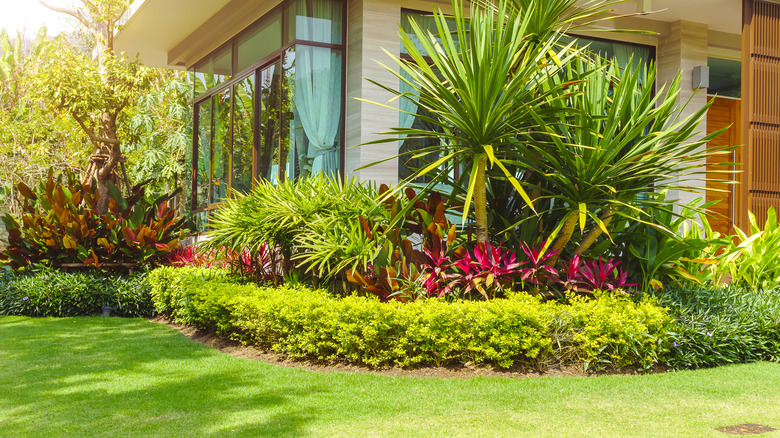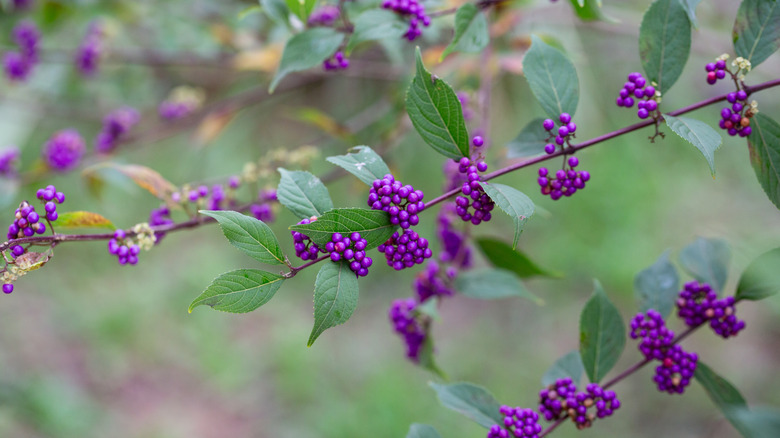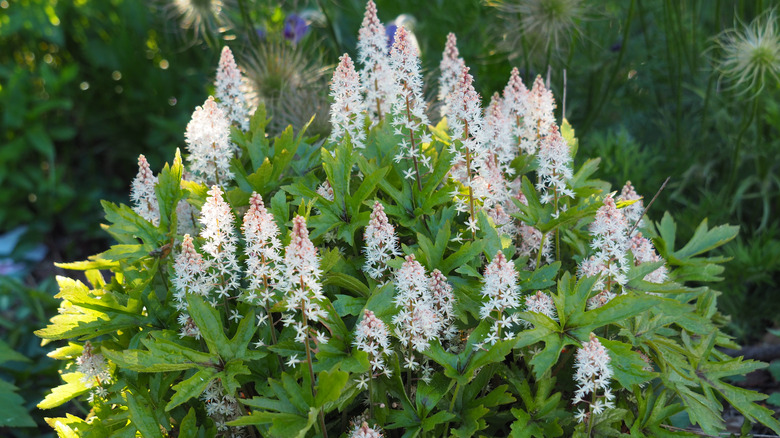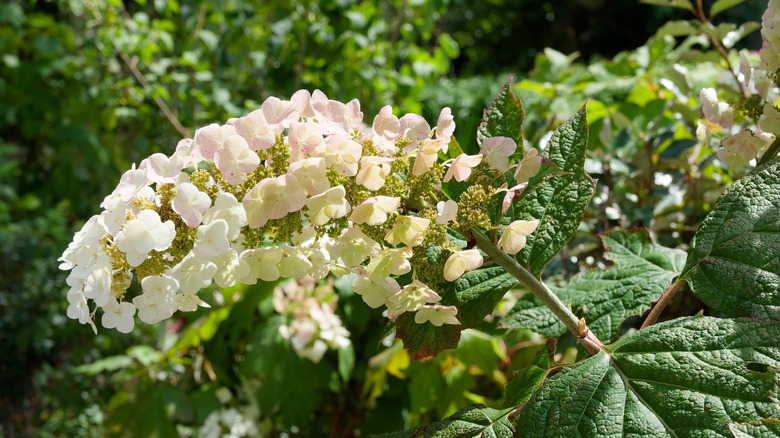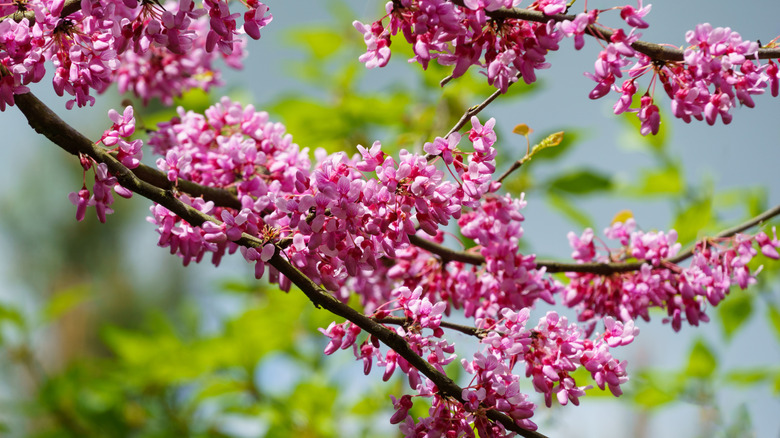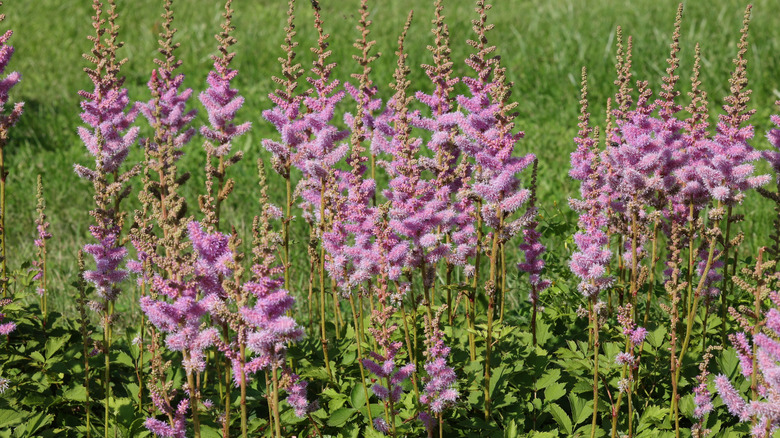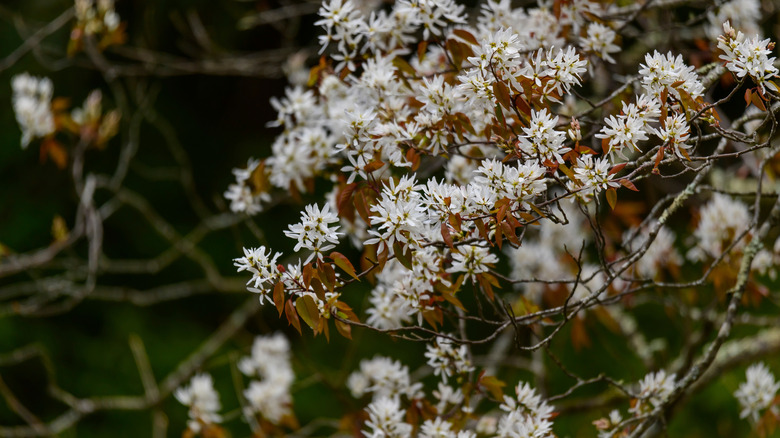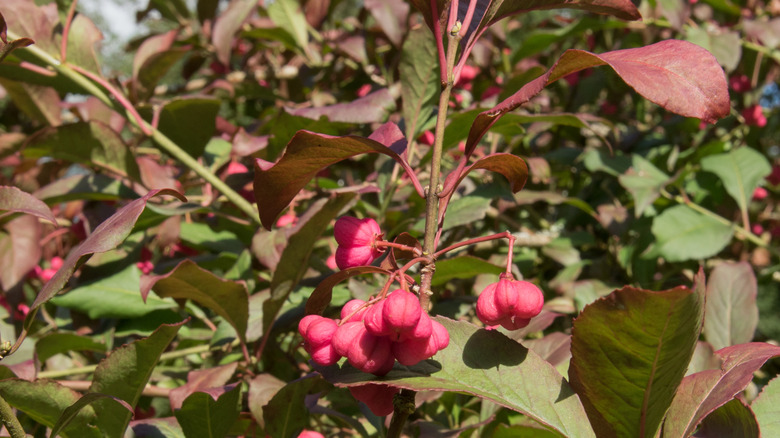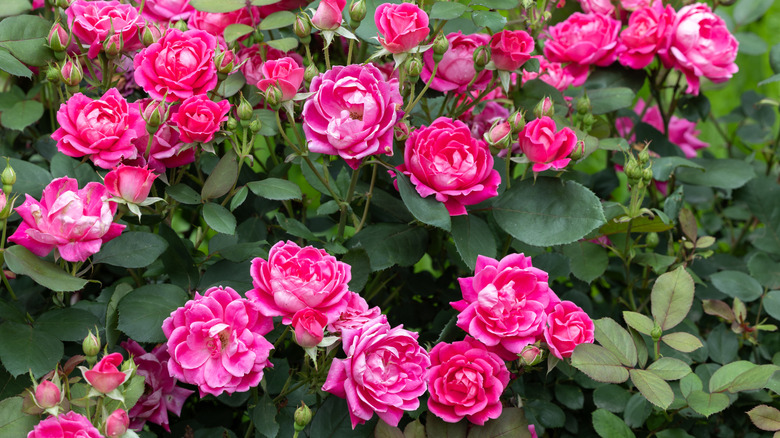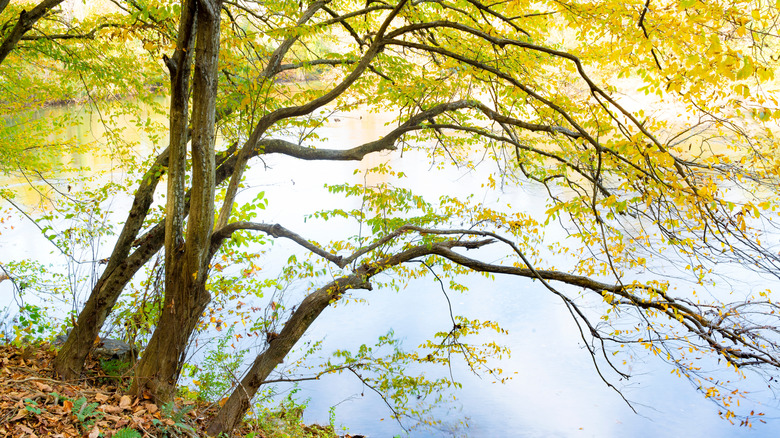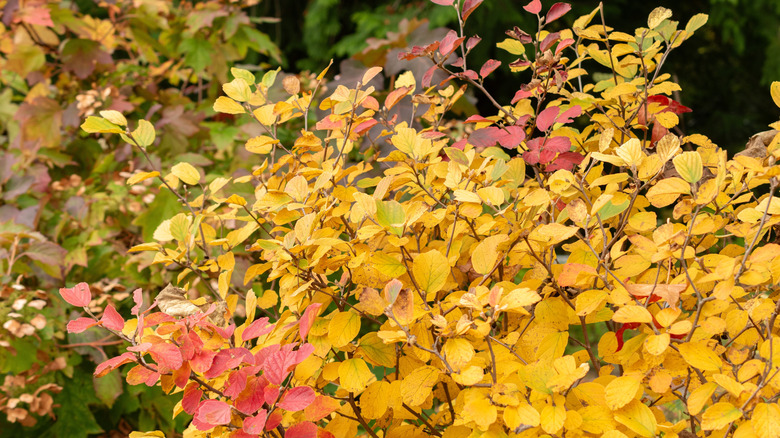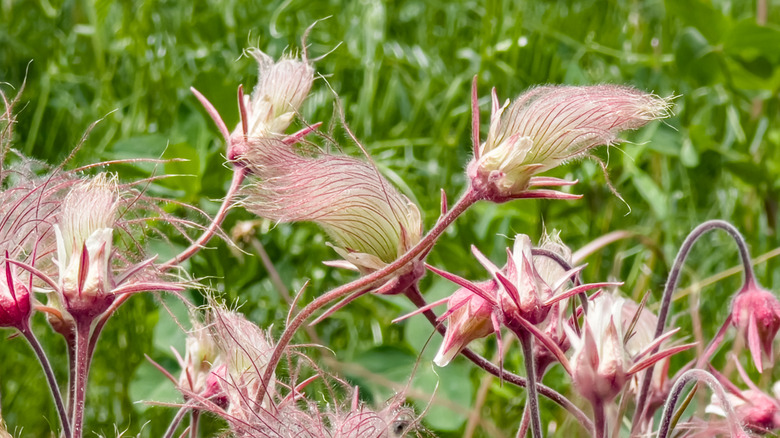14 Beautiful Plants For Your Front Yard That Will Add Major Curb Appeal
Your front yard is one of the first things visitors to your home will notice, so make it count. Boosting curb appeal isn't just about planting flowers that will have your neighbors staring, though that is a bonus. A well-landscaped front yard not only improves your home's appearance, but can also boost its value. However, you don't want to choose plants at random. The key is picking the right species and arranging them in a way that creates that magazine-worthy look.
When choosing your plants, think of the time of year when their beauty will shine the most. By doing so, you can make sure your landscape is stunning no matter what season it is. Native options are always best, as they tend to be easier to care for and are better for the environment. Layer plants of different heights and use plantings to draw the eye to key features of your front yard, such as the porch or pathways. If you're not sure where to start, below are trees, shrubs, flowers, and grasses that will take your front yard from simple to stunning.
Plant beautyberry for vibrant purple berries that last into winter
Beautyberry (Callicarpa americana) is one of the most beautiful native shrubs (native to central and southeastern U.S.) you can add to your front yard landscaping if you want multi-season interest. In late spring or early summer, this shrub puts out clustered, dainty flowers in shades of pink, purple, blue, or white that are perfect for inviting more butterflies to the landscape. While the flowers are pretty, the real standout feature is the clusters of rich purple berries that line the branches at the beginning of fall, often persisting through winter. Growing roughly 3 to 8 feet, this stunner is perfect for creating a colorful border, mass plantings, or even in large containers for a striking focal point that'll persist into the colder months.
Beautyberry is surprisingly easy to care for and can grow in almost any soil, even in textures like sand or clay. It's also wet soil tolerant, making it great for areas of your front yard that have a lot of runoff. Plant this shrub in an area where it will receive partial to full sun, and where its showy fruit will be on full display. This perennial thrives in USDA Hardiness Zones 6 to 10, where it'll return for years to come.
Add foamy bells to liven up borders
Foliage plants are one of the key ingredients for creating curb appeal, but there's one gorgeous option you may have never heard of. Meet foamy bells (Heucherella), a hybrid plant that combines the colorful leaves of coral bells (Heuchera) with the abundant flowering of foam flowers (Tiarella cordifolia). There are dozens of cultivars to choose from, with a wide variety of foliage shapes, colors, and textures. You can even find both filler and spiller varieties if you want to create a dynamic container garden. That said, these clumping perennials add more interest no matter where you stick them; they beautifully liven up borders and walkways, grow well in rock gardens, and will make a big impact in small groups. The options are endless!
Heucherella grows best in partial shade with morning sun, though it can handle a bit more sunlight in regions with cooler climates. Once established, varieties with darker foliage tend to have a higher sun tolerance than their lighter-leaved counterparts. They're also tolerant of deep shade, so they'll thrive even on a low-light patio or in those tricky, shadowy areas near the foundation. They're happiest in moist, rich soil with a neutral pH, as long as it drains well. These compact perennials grow 12 to 18 inches tall and are winter-hardy in Zones 4 through 11.
Grow oakleaf hydrangea to bring gorgeous seasonal color to your yard
Oakleaf hydrangeas (Hydrangea quercifolia) are dream plants if the goal is to boost curb appeal. In late spring to early summer, they put out showy, cone-shaped clusters of creamy white flowers that slowly fade to pink and then bronze over time. When not in bloom, the dark green, oak-like leaves provide a beautiful backdrop for foreground plants. As summer fades to fall, the foliage transforms into brilliant autumn shades of orange, red, or purple. These shrubs are attractive even in winter, with exfoliating brown bark that peels away to reveal warm cinnamon-colored layers beneath. These hydrangeas make a statement, so allow them to shine as an accent or a foundation planting.
As far as shrubs go, oakleaf hydrangeas are surprisingly low-maintenance. Winter hardy in Zones 5 through 9, they can grow in partial shade, though full sun will encourage the best blooms. They thrive in organically rich, well-draining soils. Consistent moisture is key, so it's a good idea to add a layer of mulch to help the soil retain water. Make sure to account for their somewhat large size of 10 feet, or opt for a more compact cultivar if you have a smaller front yard.
Use mountain laurel as an evergreen accent shrub or tree
Mountain laurel (Kalmia latifolia) is an evergreen shrub with an abundance of flowers that'll add a major wow factor to any front yard. Their pink, bell-shaped blooms emerge in terminal clusters, covering the plant for several weeks in late spring or early summer. These nectar-rich cups will bring in a slew of pollinators, like hummingbirds, butterflies, and other pretty visitors. Because it's winter hardy in Zones 4 to 9, it's one of the best options for having greenery in your yard year-round, even in colder climates. Either a large shrub or a small tree, it's best suited as an accent plant or used in mass to create a colorful border.
This specimen plant can tolerate full sun to partial shade, so you can put it just about anywhere in your yard. That said, it's happiest when given morning sun followed by some shade in the afternoon. It's a little bit pickier when it comes to soil, and cannot grow in heavy clays or wet sites. Instead, opt for moist, acidic, hummusy soils with good drainage.
Grow an eastern redbud tree for an early spring explosion of pink blooms
For a show-stopping pink tree that birds love to visit, you can't go wrong with eastern redbud (Cercis canadensis). Before the foliage appears, it welcomes the season with clusters of rosy pink flowers that cover the bare stems for a breathtaking early-spring display. Its abundance of blooms won't just catch the eye of anyone who walks by, but pollinators like hummingbirds, bees, and butterflies will flock to sip the nectar. In fall, several species of songbirds will perch on the branches and snack on the seeds. You can enjoy its standalone beauty as a specimen plant or combine it with other perennials or shrubs to create a mixed border in your front yard.
Eastern redbud can tolerate full sun, though partial shade is better if you're in a climate with hot summers. It isn't too picky about the pH or texture of the soil, but it will not grow well in wet or poorly draining sites. You can grow this beautiful tree in Zones 4 to 8, where it will reach up to 20 to 30 feet tall and 20 to 35 feet wide. The 'Ace of Hearts' cultivar is smaller and grows to only about 12 feet, so it can even works well as a patio tree.
Mix in false goat's beard to add color and texture to shady areas
If you're looking for beautiful flowers that grow perfectly in shade, false goat's beard (Astilbe japonica) is a great option. It features attractive fern-like foliage and elongated clusters of small, white or yellow-tinged flowers that bloom for weeks in early to late summer. It's perfect for adding moderate height to the back of a garden bed, planted en masse, or used to line paths. When layering, this roughly 2-feet-tall perennial is useful for creating a gentle transition from taller trees and shrubs to lower-growing flowers.
False goat's beard is a true shade lover, but it can grow in a sunny location as long as it's given plenty of moisture. If the soil is too dry, it won't take long for the leaves to turn brown. Although this plant thrives in moist soil, it cannot survive soils with poor drainage, so you'll need to amend heavy soils with organic matter before planting. Rich, hummusy soil is ideal. This perennial grows well in Hardiness Zones 4 to 9.
Plant serviceberry for four-season interest with blooms, berries, and fiery fall foliage
Sometimes referred to as shadbush, serviceberry (Amelanchier spp.) is a native berried tree you'll want to grow for all of its benefits. It's one of the earliest spring-flowering shrubs, boasting clusters of pretty white flowers that line bare branches for only about a week. However, it's the small, purplish edible berries that follow in early summer that are the real star of the show. They also can attract over 40 species of birds to your yard. In fall, the foliage turns to attractive shades of gold, orange, and burgundy. Serviceberries are perfectly suited for several areas of the front yard, whether you want an accent plant or something to complement a water feature.
Serviceberry trees thrive in USDA Zones 4 through 9, and grow beautifully in yards that receive full sun to partial shade. They prefer moist, rich, well-drained soil that's neutral to acidic. In alkaline soil, they may develop a condition called chlorosis, in which leaves do not produce enough chlorophyll. Once established, these plants typically reach 15 to 25 feet in height and spread, though their suckers can give them a more shrubby appearance.
Choose eastern wahoo for showy winter berries
Another shrub known for gorgeous berries, eastern wahoo (Euonymus atropurpureus) is sure to bring drama to your yard across multiple seasons. While its spring maroon flowers aren't as ornamental, the magenta seed capsules that emerge in fall will have passersby doing a double-take, especially against the gold or burgundy leaves. Although it has some gangly growth, this only allows the fruits to stand out even more. Its airy branching and small stature offer some vertical interest without feeling bulky, making it perfect for framing corners or softening harsh lines.
Eastern wahoo likes a lightly shaded area, though it prefers full sun to partial shade, it can tolerate full shade. It's also tolerant of a variety of well-draining soil types, though it prefers moist, fertile loams. In perfect conditions, it may grow into a small tree at 25 feet, but it can also grow as a smaller shrub that's closer to 12 feet. Because it thrives in Zones 3 to 8, even those living in climates with harsh winters can enjoy its beauty.
Opt for 'Knock Out' roses to get bold color that lasts from spring to frost
You can't go wrong with a rose bush, but 'Knock Out' roses (Rosa 'radrazz') are a must-have if you want low-maintenance curb appeal. They're prolific bloomers that offer roses that appear in spring with repeat blooming all the way to autumn. Don't worry, however, they're self-cleaning, so deadheading isn't required. As the flowers fade, the leaves turn to a rich red shade for a beautiful fall landscape. They come in single or double-flowered blooms in shades of pink, peach, red, orange, yellow, and white. Growing only 3 to 4 feet tall and wide, they're versatile enough to use for mass plantings, borders, lining pathways, or in containers.
With all the added benefits, it's easy to assume 'Knock Out' roses would be fussy, but it's actually the opposite. They're more tolerant than many other plants in the rose family, withstanding heat, humidity, and shadier conditions with ease. While they're somewhat reliable bloomers in partial shade, they'll reward you with their best blooms when given full sun. Plant them in moist, neutral to acidic, well-draining loams for them to grow their best. Hardy in Zones 4 to 11, nearly anyone can enjoy this low-maintenance variety.
Use 'Blue Heaven' little bluestem to add airiness to borders
There are several advantages to growing ornamental grass in your yard, particularly if you want effortless texture and color added to your landscape. Little bluestem has been a reliable native prairie grass for many, but the 'Blue Heaven' (Schizachyrium scoparium 'MinnBlueA') variety stands out for its exceptional multi-season color. Its upright foliage emerges in a gorgeous blue, making it the perfect accent for rock gardens, containers, borders, or mixed plantings. Towards the end of the summer, the grass transitions to shades of pink and burgundy, with pretty purple flowers hovering above the blades. Finally, it turns to a gorgeous copper fall color, and the flowers become silvery-white seed heads that last until into winter.
Once you plant 'Blue Heaven' in the ground, most of the work is already over. Aside from full sun, this grass doesn't have too many requirements. It can tolerate most soil types, whether it's clay, dry, or nutritionally poor, and can withstand the heat and humidity in southern U.S. regions. This little bluestem variety is also hardy in Zones 3 to 10, doing well even in freezing winters. All you'll need to do is cut it to the ground at the end of winter or the beginning of spring, and its blue blades will reemerge year after year.
Plant an American hornbeam tree to create a stunning focal point in your front yard
Sometimes nicknamed "musclewood" because of its rippling bark, American hornbeam (Carpinus caroliniana) is an attractive understory tree that's perfect for shady parts of the yard. The flowers may be inconspicuous, but you'll understand why this tree is an understated beauty when fall and winter roll around. In autumn, the green leaves turn to brilliant reddish-orange shades that will give your yard a pop of color when most of your other flowers have faded. The best part? Their leaves hang on for longer than most, often staying on the tree through winter, only falling off when new growth pushes through. At this time, the bluish, sculpted bark pops, especially against a white, snowy backdrop.
As an understory tree, the American hornbeam doesn't just tolerate shady sites; it will thrive in deep shade. It does best in sandy or clay soils that are organically rich and slightly acidic. It's a moisture-lover that doesn't do well in drought, so it's a good option next to front yard ponds or other water features. Because it doesn't have aggressive roots, you can safely plant it near the house. It grows slowly, so make sure you plant it at least 15 feet away from buildings to accommodate its spread. The largest it may get is 35 feet, but it responds well to pruning and shaping. This stunning native is hardy in Zones 3 to 9.
Introduce coneflowers to sunny beds for colorful blooms with minimal upkeep
It's easy to see why coneflower (Echinacea) has been a garden staple for decades. In fact, its use goes back centuries to when Native Americans would use it to treat a variety of illnesses. Aside from qualities that can turn it into a comforting tea, it's also one of the best flowers you can use to add curb appeal. These summer-blooming perennials feature large, purplish daisy-like blooms that are a must-have if you want bright splashes of color added to your front yard. They typically fade toward mid-fall, when the centers become a seed-filled buffet for songbirds, like goldfinches. Their uses are nearly endless, whether mixed with other perennials or alone in beds and borders.
Coneflowers are full sun lovers that thrive in Zones 3 to 8, though they can grow in partial shade. They like moist, well-drained loams, but they can adapt to several soil conditions, including dry or poor soil. These tough flowers can also grow well in areas with summer heat and humidity. Once established, coneflowers are extremely drought-tolerant and will only need occasional supplemental watering.
Plant dwarf fothergilla for attractive foliage throughout the seasons
With its fiery fall foliage, dwarf fothergilla (Fothergilla gardeni) is one of the best alternatives for invasive burning bush plants in the garden. This showy shrub stays attractive throughout several months, starting with its white bottlebrush flowers in spring. Its lush green foliage in summer will turn to vibrant shades of orange, red, and yellow for a colorful fall display. Its compact size makes it an excellent choice for foundation plantings, low hedges, or mixed borders.
This versatile shrub is easy to keep happy in Zones 5 to 8. You can plant it in an array of light conditions, from full sun to partial or dappled shade in preferably rich, slightly acidic, well-draining soil. That said, for the most eye-catching fall color and flower display, it's best to choose a sunny site with some afternoon shade. Dwarf fothergill isn't picky about watering either, as it's tolerant of both compact, wet soils and drought.
Use prairie smoke as a groundcover for a cloud of pink blooms and feathery seedheads
Prairie smoke (Geum triflorum) is a stunning, lesser-known flower that's definitely worth growing in your garden. This native perennial features nodding pink flowers in spring, followed by pink, smoky, feathery seedheads that add texture and movement in fall. This interesting perennial is a no-brainer if you want to add a whimsical touch to rock gardens, borders, or beds. Give it room for its underground rhizomes to spread, and it becomes a unique ground cover for a soft, meadow-like feel.
This plant will happily grow in nearly any soil you stick it in, whether it be loamy, sandy, or clay type. While it can tolerate light shade, the best flowering occurs when it's given at least six hours of full sun. Give it plenty of water in spring, cut back a bit during summer, and avoid overwatering in winter for best growth. Naturally growing in prairies and grasslands, you can grow this unique beauty in Zones 3-7.
